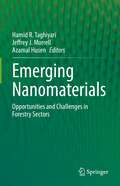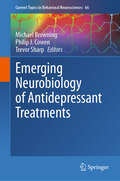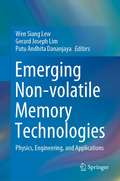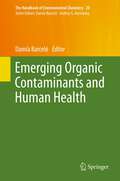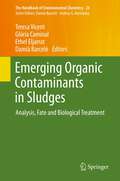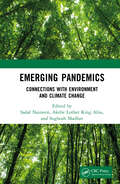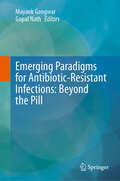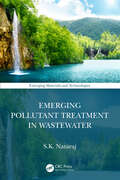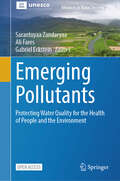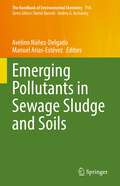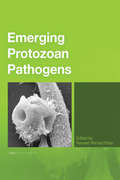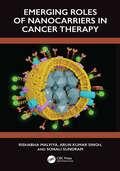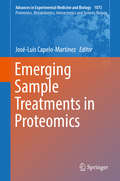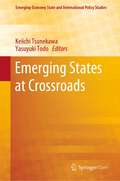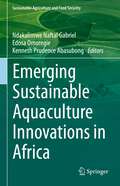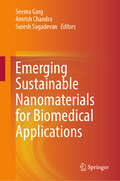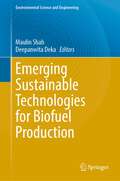- Table View
- List View
Emerging Nanomaterials: Opportunities and Challenges in Forestry Sectors
by Hamid R. Taghiyari Jeffrey J. Morrell Azamal HusenBio-based materials, including those containing wood, will become increasingly important as we move to a bio-based economy. Among their many attributes, it is vitally important that these materials are renewable, sustainable with proper management and environmentally benign. Wood remains one of our most important bio-based materials. While it is an amazing material, wood still has negative attributes and drawbacks that can affect performance, including dimensional instability when wetted, vulnerability to fire and high temperatures, and susceptibility to biodeterioration. A variety of treatments have been developed to overcome these weaknesses. Among the most exciting of these treatments are nanomaterials. These materials have some exceptionally attractive properties for improving timber performance and have been the subject of intensive research over the past decade. There is a tremendous need for a single comprehensive source of information on this rapidly emerging subject with tremendous potential to enhance the performance of a variety of bio-based materials. This book contains 10 chapters, each compiled by different author(s) who are considered the top researcher(s) in their respective fields. The chapters begin with some basic background on nanomaterials and their synthesis, then explore different areas for potential applications and conclude with a review of the emerging questions about nanomaterial safety. The book is designed to provide the latest information and know-how on application and utilization of different nanomaterials to improve the properties of wood and wood-based composite panels. The contents cover some main topics in the industry including improving physical and mechanical properties, increasing resistance to biodegradation (including fungi and insects), developing wood-plastic composites (WPC), applying nanomaterials in paper and board industry, and emergence of transparent wood and radiation shielding. It also covers the use of nanomaterials to improve the performance of paints and finishes used for forest products. The book provides a single location for those interested in the field to begin.
Emerging Nanomaterials for Advanced Technologies (Nanotechnology in the Life Sciences)
by Ram Prasad Hendrik C. Swart Anand Krishnan Balasubramani Ravindran Balamuralikrishnan Balasubramanian Sarojini Jeeva PanchuOver the past decade the world has seen the rise of the fascinating and diverse field currently recognized as nanotechnology. This book covers a broad spectrum of topics within nanotechnology, including synthesis techniques, various innovative characterization techniques, growth mechanisms of nanomaterials, the physics and chemistry of nanomaterials, diverse functionalization methods, and the various applications of nanomaterials in biology, therapeutics, energy, food science, and environmental science. It also discusses applications of nanostructured materials, integrative applications such as nano- and micro-electronic sensor devices, as well as agricultural and environmental remediation applications. The book also includes a discussion of advances in functionalized nanomaterials (0D, 1D, 2D and 3D) and covers the early stages of the development of functionalized nanostructures, considering the future for 2D nanomaterials and 3D objects. Additionally, it includes a chapter on nanomaterial research development that highlights work on the life-cycle analysis of nanostructured materials and toxicity aspects.This book proves useful for researchers and professionals working in the field of nanomaterials and green technology, as well as in the field of nanotechnology. It should be useful to students and specialized researchers in a number of disciplines ranging from biology, chemistry, and materials science to engineering and manufacturing in both academia and industry.
Emerging Nanotechnologies in Nanocellulose (NanoScience and Technology)
by Liangbing Hu Feng Jiang Chaoji ChenThis book provides expert coverage of the current state of the art in the application of nanotechnologies to cellulose research. It offers a comprehensive collection of topics including nanocellulose isolation, assembly into hierarchical structures, and advanced emerging applications. During the past decades, research in nanocellulose has advanced quickly, driven by the urgent needs for sustainability and the availability of advanced nanotechniques. Although cellulose has been investigated and used for thousands of years, the recent advances in nanotechnology have transformed our view of this natural substance. Cellulose, when present in the highly crystalline nanoscale form, can demonstrate interesting mechanical, optical, and fluidic properties that can be manipulated in designing materials with novel applications.This book contains 12 chapters. Chapter 1 focuses primarily on the fundamentals of nanocellulose, including general aspects on its structure, isolation, and characterization. Chapters 2-4 summarize the recent progress on assembly of nanocellulose into the macroscopic scale using state-of-the-art techniques. Chapters 5-13 cover the most advanced applications of nanocellulose in emerging areas, including superstrong materials, light management, electronics, energy storage, printed battery, water treatment, nanogenerator, and biomedicine. The book will appeal to upper undergraduate and graduate students through practicing researchers as a comprehensive reference on the subject of nanocellulose and its use in various fields.
Emerging Neurobiology of Antidepressant Treatments (Current Topics in Behavioral Neurosciences #66)
by Michael Browning Trevor Sharp Philip J. CowenThis volume is unique in bringing the exciting range of antidepressant treatment developments together with a focus on their neurobiological mechanisms and how these interact with the known pathophysiology of depression. Current evidence for treatment efficacy is reviewed together with a discussion of where in the management pathway of this common condition, these new approaches might take their place.
Emerging Non-volatile Memory Technologies: Physics, Engineering, and Applications
by Wen Siang Lew Gerard Joseph Lim Putu Andhita DananjayaThis book offers a balanced and comprehensive guide to the core principles, fundamental properties, experimental approaches, and state-of-the-art applications of two major groups of emerging non-volatile memory technologies, i.e. spintronics-based devices as well as resistive switching devices, also known as Resistive Random Access Memory (RRAM). The first section presents different types of spintronic-based devices, i.e. magnetic tunnel junction (MTJ), domain wall, and skyrmion memory devices. This section describes how their developments have led to various promising applications, such as microwave oscillators, detectors, magnetic logic, and neuromorphic engineered systems. In the second half of the book, the underlying device physics supported by different experimental observations and modelling of RRAM devices are presented with memory array level implementation. An insight into RRAM desired properties as synaptic element in neuromorphic computing platforms from material and algorithms viewpoint is also discussed with specific example in automatic sound classification framework.
Emerging Organic Contaminants and Human Health
by Damia BarceloThis volume provides an overview of the occurrence and fate of emerging contaminants, discusses advanced chemical analysis methods, toxicological and ecotoxicological effects as well as human exposure. One focus is on pharmaceuticals, in particular antibiotics, and the problems associated with their increased use in hospitals. Other covered emerging contaminants occurring e.g. in food, water, air or soil include brominated flame retardants, polar pesticides, phthalates, phosphate esters, perfluorinated compounds, personal care products, musk fragrances, disinfection byproducts, illicit drugs, and nanomaterials. The chapters written by experts are a valuable source of information for a broad audience, such as analytical chemists, environmental chemists and engineers, toxicologists, ecotoxicologists and epidemiologists working already in this field as well as newcomers.
Emerging Organic Contaminants in Sludges
by Ethel Eljarrat Glòria Caminal Damià Barceló Teresa VicentThere are a growing number of new chemicals in the environment that represent an ascertained or potential risk. Many of them can be found in sewage sludge and are the subject of this volume. Experts in the field highlight their occurrence and fate, risks of biosolid use, advanced chemical analysis methods, and degradation techniques with a special focus on biodegradation using fungi. In the final chapter conclusions and trends are offered as a point of departure for future studies. The double-disciplinary approach combining environmental analysis and engineering makes the book a valuable and comprehensive source of information for a broad audience, such as environmental chemists and engineers, biotechnologists, ecotoxicologists and professionals responsible for waste and water management.
Emerging Pandemics: Connections with Environment and Climate Change
by Sadaf Nazneen, Akebe Luther King Abia, and Sughosh MadhavPandemics are often associated with viruses and bacteria occurring in wildlife in natural environments. Thus, diseases of epidemic and pandemic scale are mostly zoonotic, some of which include AIDS, Zika virus, severe acute respiratory syndrome (SARS), and COVID-19. The book seeks to explore the documented history of pandemics and various epidemics that have the potential of turning into pandemics with the warming climate, pollution, and environmental destruction. The book covers some of the most essential elements of the diseases of pandemic nature and their relationship with the environment: Environment as a reservoir of human diseases Climate change: emerging driver of infectious diseases Occurrence and environmental dimensions of specific pandemics and epidemics Pandemics, environment, and globalisation: understanding the interlinkage in the context of COVID-19 Climate change and zoonotic diseases: malaria, plague, dengue, encephalitis Tuberculosis: an old enemy of mankind and possible next pandemic Lassa fever in Nigeria: case fatality ratio, social consequences, and prevention There are cases where scientists fear that many epidemics have the potential of turning into pandemics, if we do not pay attention to them, and measures are not being taken to control these occurrences. This book attempts to provide integrated risk assessment on pandemics like COVID-19. It covers fundamental factors of global disease outbreaks through the complexity and severity of consequences. The information collated in this book will help in the design of mitigation measures, including behavioral changes that could prevent the emergence of such pandemics, thus protecting human life and minimising losses incurred due to diseases of such magnitude.
Emerging Paradigms for Antibiotic-Resistant Infections: Beyond the Pill
by Mayank Gangwar Gopal NathThis book delves into antibiotic resistance, offering insights into its emergence, mechanisms, and impact on global health. The book also scrutinizes over-prescription, agricultural use, and the scarcity of new drug development, while spotlighting the role of globalization in its propagation. It moves beyond conventional approaches, examining alternative strategies like phage therapy, immunotherapy, and nanotechnology. Highlighting precision diagnostics and the importance of policy implications, it navigates through public health strategies, surveillance, and international collaborations. Finally, it glimpses into the future, delineating the challenges, opportunities, and the urgency of action required to steer away from a post-antibiotic era. This book serves as an invaluable resource for students, researchers, and scientists in the fields of medicine, pharmacy, microbiology, and public health.
Emerging Pollutant Treatment in Wastewater (Emerging Materials and Technologies)
by S.K. NatarajThis book highlights the innovations and techniques to identify and treat the emerging pollutants in waste and polluted water. It initiates with classification of emerging pollutants followed by a review on existing detection and elimination techniques, and current regulations in place. Subsequent chapters cover membrane-based separation process, polymer-based or resin-based water filters, functional materials, nanomaterials-based adsorbents, microplastics, and summary of the potential solutions in treating or removing emerging pollutants. Features Presents an overview of current and developing treatment technologies for water polluted with emerging pollutants Gives in-depth account and analysis of advanced materials and methods for separation and treatment Reviews analytical techniques applied to detect emerging pollutants Discusses overall effect of policies on current chemicals/plastics/APIs in the market Includes pertinent case studies and regulations The book is aimed at researchers, professionals and graduate students in environmental/civil/chemical engineering, wastewater/drinking water treatment.
Emerging Pollutants: Origin, Structure, and Properties
by Francisco G. Calvo-Flores Joaquin Isac-Garcia Jose A. DobadoAn excellent, concise, and interdisciplinary overview of different classes of emerging pollutants arising, for example, from pharmaceuticals, pesticides, personal care products, and industrial chemicals and their impact on water, soil, and air. Following an introduction to chemical pollutants, with special attention focused on organic compounds and their properties, the book goes on to describe major emerging pollutants grouped according to their applications in different sectors of industrial or economic activity. For each type of compound, the chemical structure, main properties, and source are presented, along with their fate in the environment as pollutants, the latest analytical methods for detection, possible health or ecology consequences, as well as current regulatory laws. New developments, such as nanotechnology as a pollution source, are also included. The book closes with a chapter devoted to conclusions and future perspectives.
Emerging Pollutants: Protecting Water Quality for the Health of People and the Environment (Advances in Water Security)
by Sarantuyaa Zandaryaa Ali Fares Gabriel EcksteinThis open access book focuses on the importance of reducing pollution and protecting water resources for the health of people and the environment. Water is vital for life on Earth. The quality of the world's freshwater resources is deteriorating due to the rise in pollution levels, which puts the health of people and the environment at risk. Emerging pollutants, a new class called Contaminants of Emerging Concern, pose a global water quality challenge. The identification and implementation of appropriate regulatory, monitoring, prevention, and control measures are hindered by limited scientific understanding and knowledge about sources and pathways of emerging pollutants, their behaviour and fate in the environment, and potential human and ecosystem health risks. The book presents selected contributions to the UNESCO-IWRA Online Conference “Emerging Pollutants: Protecting Water Quality for the Health of People and the Environment,” held on 17–19 January 2023. It offers an extensive overview of current research findings on emerging pollutants in aquatic ecosystems, groundwater contamination, wastewater management and reuse, circular economy approaches to pollutant lifecycle management, and the prioritization of emerging pollutants in the hydro-cycle. Based on scientific evidence and policy-relevant research findings, the book’s concluding chapter highlights research and policy gaps, offering recommendations for strategic and practical ways to manage emerging pollutants towards sustainable water management in the face of global changes and evolving environmental threats. This book is a scientific output in the framework of UNESCO Intergovernmental Hydrological Programme’s Ninth Phase “Science for a Water-Secure World in a Changing Environment” (IHP-IX, 2022-2029) and UNESCO-IHP’s International Initiative on Water Quality (IIWQ) in collaboration with the International Water Resources Association (IWRA).
Emerging Pollutants in Sewage Sludge and Soils (The Handbook of Environmental Chemistry #114)
by Avelino Núñez-Delgado Manuel Arias-EstévezThis book provides an authoritative overview of emerging pollutants in sewage sludge and soils. It traces the latest research and new trends on the characterization, removal and treatment of such pollutants in urban and industrial sewage sludge and soils. The book covers topics such as antibiotic resistance, fate and environmental impact of contaminants of emerging concern, environmental transmission of human pathogenic viruses and their effect on soil, and the repercussion of various emerging pollutants on biodiversity. It also offers a case study of the epidemiology-based surveillance of SARS-CoV-2 in wastewater and sludge. The book appeals not only to researchers and professionals working with emerging contaminants, but also to policy makers and a broader audience interested in learning more about the effects of these contaminants in human and environmental health.
Emerging Protein Biotherapeutics
by Iqbal S. GrewalGiven the speed at which antibody therapy is becoming readily accepted, a comprehensive industry guide is sorely needed. Written by leading international authorities, this book maintains an overall emphasis on various therapeutic approaches and applications and provides critical discussions on the most significant areas of research in biologics. It focuses on the applications of protein biologics in autoimmunity and inflammation, hematological malignancies, and solid tumors. Each chapter clearly presents the most informative and contemporary account of its subject available, making this an unrivaled reference source beneficial to those in both academia and biotechnology industries.
Emerging Protozoan Pathogens
by Naveed Ahmed KhanEmerging protozoan pathogens, once thought to be an obscure menace of society, have become a major threat to human health. The last two decades have seen major advances in the understanding of these increasingly important pathogens. Emerging Protozoan Pathogens provides a comprehensive account of up-to-date information on the present status of research in this discipline. Written by experts in their respective subject areas, this book provides a valuable resource for microbiologists and molecular and cell biologists at advanced undergraduate and graduate levels, as well as health professionals and researchers who are interested in these pathogens. The material covered, including biology, genomics, epidemiology, pathogenesis and treatments, makes it an ideal platform on which to base further research projects.
The Emerging Quantum
by Luis de la Peña Ana María Cetto Andrea Valdés HernándezThis monograph presents the latest findings from a long-term research project intended to identify the physics behind Quantum Mechanics. A fundamental theory for quantum mechanics is constructed from first physical principles, revealing quantization as an emergent phenomenon arising from a deeper stochastic process. As such, it offers the vibrant community working on the foundations of quantum mechanics an alternative contribution open to discussion. The book starts with a critical summary of the main conceptual problems that still beset quantum mechanics. The basic consideration is then introduced that any material system is an open system in permanent contact with the random zero-point radiation field, with which it may reach a state of equilibrium. Working from this basis, a comprehensive and self-consistent theoretical framework is then developed. The pillars of the quantum-mechanical formalism are derived, as well as the radiative corrections of nonrelativistic QED, while revealing the underlying physical mechanisms. The genesis of some of the central features of quantum theory is elucidated, such as atomic stability, the spin of the electron, quantum fluctuations, quantum nonlocality and entanglement. The theory developed here reaffirms fundamental scientific principles such as realism, causality, locality and objectivity.
Emerging Research in Alternative Crops (Environment & Policy #58)
by Abdelaziz Hirich Redouane Choukr-Allah Ragab RagabThis book provides case studies on cultivating alternative crops and presents new cropping systems in many regions of the world. It focusses on new emerging research topics aiming to study all aspects of adaptation under several stresses including agricultural, environmental, biological and socioeconomic issues. The book also provides operational and practical solutions for scientists, producers, technology developers and managers to succeed the cultivation of new alternative crops and, consequently, to achieve food security.Many regions in the world are suffering from water scarcity, soil and water salinization and climate change. These conditions make it difficult to achieve food security by cultivating conventional crops. A renaissance of interest for producing alternative crops under water scarcity and water salinization has been, therefore, implemented primarily among small-scale producers, researchers and academics.The use of alternative crops (quinoa, amaranth, legume crops, halophytes, …etc.) may provide some environmental benefits such as valorization of salt-affected soils, reduced pesticide application, enhanced soil and water quality and promotion of wildlife diversity. This also may provide some economic benefits such as providing the opportunity for producers to take advantage of new markets and premium prices, spreading the economic risk and strengthening local economies and communities. Furthermore, alternative crops are often rich in proteins and minerals, and even some of them are Gluten free (quinoa). This reflects their importance to achieve food security in quantity and quality scale. The year 2013 was exceptional for alternative crops as it was the international year of quinoa celebrated by Food and Agriculture Organization (FAO). This reflects the importance of research conducted on quinoa and other alternative crops in many regions of the world.
Emerging Research Trends in Medical Textiles
by N. Gokarneshan D. Anitha Rachel V. Rajendran B. Lavanya Arundhathi GhoshalThis book provides a comprehensive review of the significant researches reported during the recent years in the field of medical textiles. It also highlights the use of new types of fibres in developing medical textile products and their promising role in the respective areas of application. Considerable developments have taken place in the development of medical textiles for varied applications.
Emerging Roles of Nanocarrier in Cancer Therapy
by Arun Kumar Singh Rishabha Malviya Sonali SundramThis book addresses the limitations of existing therapeutic approaches using nanoparticles. Emerging Roles of Nanocarriers in Cancer Therapy will further provide information for the development of successful cancer nanomedicine therapies.Features Explains different types of nanoparticles, targeting mechanisms, and approved nanotherapeutics for oncological implications in cancer treatment. Covers in detail the characteristics of various nanotechnology-based drug delivery systems. Discusses passive and active cellular targeting, ligand-based targeting of nanoparticles, and strategies to improve nanoparticle-cellular membrane interaction. Presents the application of nanotherapeutics, current challenges, and prospects, and describes the path of future research. Highlights smart strategies for improving the clinical impact of cancer nanomedicine. The text is primarily written for graduate students, and academic researchers in the fields of biotechnology, nanotechnology, drug delivery, pharmaceutical science, and pharmacology.
Emerging Sample Treatments in Proteomics (Advances in Experimental Medicine and Biology #1073)
by José-Luis Capelo-MartínezProteomics is a well-established area of Science; yet with a strong area in constant evolution, namely sample treatment. There few books that currently cover the field of emerging sample treatments in proteomics, this new volume will be the first to cover all emerging and existing studies. This unique book presents the latest advances in the field focusing on emerging trends linked to high-resolution mass spectrometry, technology addressed to treat samples faster and to attempts to simplify the proteome for the reader.
Emerging States at Crossroads (Emerging-Economy State and International Policy Studies)
by Keiichi Tsunekawa Yasuyuki TodoThis book is open access under a CC BY-NC-ND license.This volume analyzes the economic, social, and political challenges that emerging states confront today. Notwithstanding the growing importance of the ‘emerging states’ in global affairs and governance, many problems requiring immediate solutions have emerged at home largely as a consequence of the rapid economic development and associated sociopolitical changes. The middle-income trap is a major economic challenge faced by emerging states. This volume regards interest coordination for technological upgrading as crucial to avoid the trap and examines how various emerging states are grappling with this challenge by fostering public-private cooperation, voluntary associations of market players, and/or social networks. Social disparity is another serious problem. It is deeply rooted in history in the emerging states such as South Africa and many Latin American countries. However, income distribution is recently deteriorating even in East Asia that was once praised for its high economic growth with equity. Increasing pressure for political opening is another challenge for emerging states. This volume argues that the economic, social, and political problems are interwoven in the sense that the emerging states need to build political consensus in order to tackle the economic and social difficulties. Democratic institutions have not always been successful in this respect.
Emerging Sustainable Aquaculture Innovations in Africa (Sustainability Sciences in Asia and Africa)
by Ndakalimwe Naftal Gabriel Edosa Omoregie Kenneth Prudence AbasubongThis edited book presents the emerging sustainable innovations in all areas of aquaculture in Africa with a view to create an opportunity whereby scientific outputs and recommendations can be endorsed for improved aquaculture outputs towards poverty alleviation and food security on the continent. Food insecurity and poverty are some of the challenges faced on the African continent. These challenges are further exacerbated by the growing human population and the impacts of climate change. Today, aquaculture has become one of the fastest food producing sectors in the world, with the potential to contribute significantly to food security and poverty alleviation in developing countries. In Africa, aquaculture is at an infant stage, however, many African countries have recognized the potential roles of aquaculture in food security, poverty alleviation and conservation of aquatic resources through their commitment to achieve the United Nation Sustainable Development Goals. The book reviews and synthesize research work from these thematic areas across Africa and provide a unique perspective on the emerging aquaculture innovations and illustrate how aquaculture practices could be feasible and cost effective while promoting social and environmental sustainability. The book also draws from global discussions on sustainable aquaculture practices and provides recommendations on what is feasible for Africa. This book is a great tool for the university students, scholars, aquaculture farmers, investors, and policymakers to understand the scientific based sustainable aquaculture innovations from an African perspective. This book is focused on SDG 2 and SDG 14.
Emerging Sustainable Nanomaterials for Biomedical Applications
by Seema Garg Amrish Chandra Suresh SagadevanThis book comprises a detailed overview of nanomaterials for biomedical applications and public health. Nanomaterials show various functions in medicine, sunscreens, electronic device, diagnostics, military applications, photovoltaic cells, paints, imaging, catalysts and drug delivery. In this book carbon Nanotubes/nanowires/nanofibers are explored for tissue engineering applications. Functionalized carbon nanotubes, silica Nanoparticle, silicon quantum dots, metal Decorated Nanomaterials, biogenic metal nanoparticles, magnetic functionalized nanomaterials and nanozymes have been covered for the treatment of bacterial Infections as carriers of gene delivery and for their biological applications. This book also explores nano-biotechnology and its approach for a sustainable future.
Emerging Sustainable Technologies for Biofuel Production (Environmental Science and Engineering)
by Maulin Shah Deepanwita DekaThis book is presented on biofuel production which includes different technologies developed and adopted to synthesize green renewable fuel alternatives for sustainable development. It also reflects different sources of biofuel, application of microbial community and microbial engineering to design fuel production and the biosynthetic pathways of biofuel production by microbes.Although the expenses for the physical and chemical technologies for energy production and fossil fuel utilization to protect our environment are very high, these technologies are not eco-friendly and safe. Hence, the need of certain modern eco-friendly and cost-effective techniques to protect our environment is deeply apprehended by different workers of this field. These techniques involve some feasible technologies utilizing different biological agents like microbes to produce renewable energy. This book provides an outline of the science behind the multidisciplinary aspects of biofuel production. It summarizes a solid foundation in the fundamentals and progresses to practical applications in this field. It structures stepwise route for a number of effective techniques to screen, select, identify and utilize microbes for biofuel production and utilization. It also focuses on the theoretical groundworks of biofuel production, recent technologies related to microbial engineering like myco-engineering technologies, microbial metabolism or modelling approaches to microbial physiology utilized for the same purpose. The techniques covered in this book ensure that scientists have the knowledge to practice effective biofuel production techniques themselves in a contaminated ecosystem in a sustainable way.Recent progress in the field of biofuels using microbial genetic engineering has larger perspectives in commercial-scale production. However, its large-scale production is still challenging; hence, to resolve this problem, it is essential to convert biomass into biofuels by developing novel technology to increase biofuel production to fulfil the current and future energy demand.
Emerging Syntheses In Science
by David PinesThe Santa Fe Institute, as key element in its founding activities, sponsored two workshops on 'Emerging Syntheses in Science.' There was unanimous agreement among the participants that Professor Gell-Mann's keynote address and the ensuing talks were of such high quality and general interest that it would be highly desirable to publish these for broader distribution.
